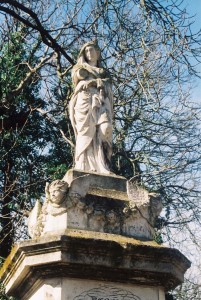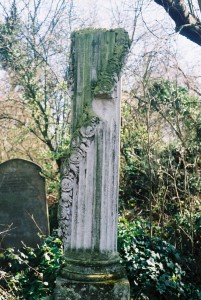© Carole Tyrrell
When you think of a Victorian cemetery what do you think of most? Angels atop of monuments pointing dramatically upwards? Crosses? As you walk around Nunhead Cemetery you will certainly see these symbols but there’s a story to be told of 19th century religious and art movements and the Victorian language of cyphers and motifs.
They loved double meanings and secret codes. For example, the stones in many a Victorian piece of jewellery were often selected to form words from the first letters of the stones or the colours chosen as in Suffragette pieces. In art, symbols and items within a painting often said more than what appeared to be the main composition as in ‘The Awakening Conscience’ by William Holman Hunt.
19th century Britain was also in the grip of religious conformity. ‘No Popery’ was the cry and any good Anglican studiously avoided crosses and angels and anything else that might even hint at Catholicism. Instead Victorians turned to ancient Rome and Greece’s classicism and so urns, draped or undraped, made their appearance. As the Romans practiced cremation it seemed appropriate. After Napoleon’s Egyptian explorations obelisks became all the rage. Nunhead has several fine examples of urns and obelisks.
However, as the 19th century wore on, the rules slowly relaxed and in the 1880s angels began to roost. Some were copied from Italian originals as is a magnificent and sensuous example in West Norwood Cemetery. The revival in Celtic arts meant that Celtic crosses, in which the arms formed a wheel, came back into fashions. There was also the language in which every flower had a meaning as with ivy which was a symbol of immortality or evergreen memories.
These are the Top 10 symbols to be found in Nunhead or other Victorian cemeteries. NB: Interpretations are not definitive – please let me know if you disagree.
- Downturned torches. These can be found on the main gates at Limesford Road and on other monuments within Nunhead including the Daniels one near the chapel. These are a Greek symbol which means ‘life extinguished’.


- Ouroboros/snake swallowing its own tail. These can be found on top of the pillars at the Limesford Road entrance. They are an ancient Egyptian symbol of eternal life and let the visitor know that they were entering a place of death and memorial. The Friends of Nunhead Cemetery have adopted this emblem as their symbol.

- IHS/ also known as the dollar sign. A lovely example can be found on the Symes memorial. It means ‘Iesus Honinum Salvator’ or translated as ‘Jesus the saviour of Man.’

4.Shaking hands. A particularly striking and beautifully carved example is on the Edward Mullins vault. There are several examples within Nunhead but these are the best in my opinion. There are several interpretations of this image: they may mean ‘Farewell’, marriage, a close bond lasting until death or the first one to die holds the surviving spouse’s hand guiding them to heaven. If on a family tomb, as they usually are, they can mean either hope or reunification in the next life or simply ‘see you soon’ which may not be as comforting as it sounds with the Victorians high mortality rate.

5. Celtic Cross. Nunhead has several fine examples decorated with Celtic strapwork or plain. However the Mills cross near the Chapel is especially lovely with it’s fine carving of passion flowers and the hand at their base with the motto ‘Thy Will be Done’. This is a deeply religious memorial as passion flowers symbolised Christ’s passion, hence their name, in passion, sacrifice and redemption. Its 5 stamen represent the 5 wounds inflicted on Christ on the cross and the 10 petals are the 10 disciples that remained faithful to him. The flower’s corona is said to be the crown of thorns.

A more conventional strapwork Celtic cross
- Urns. These are an ancient Roman symbol and there are several within Nunhead.

7. Flowers. The language of flowers is something that we’ve lost but to the Victorians it was of great importance. Ivy is an evergreen and means’ everlasting memories’ and the weeping willow is obvious.

- Mourning women. This was another symbol borrowed from Ancient Rome and a fine example is on the Daniels monument on the main avenue near the chapel.

9. Angels. Most angels in the Bible and other sources are male but in Victorian cemeteries they are usually pretty young women. There is a whole mythology around angels and what they are carrying in their hands. On the Hershel tombstone there is an angel carrying a wreath and on the Williams vault there is one pointing upwards and carrying an anchor, perhaps symbolising hope.

- Broken column. Nunhead has several examples and at first it can look like deliberate vandalism. These could mean mortality, the support of life being broken and maybe the grave of the head of the family. A variation is the empty chair in Highgate cemetery whose meaning is obvious, The Hawker memorial boasts a lovely example. Although damaged, and in its swirling garland of roses is very reminiscent of the Apprentice Pillar in the Rosslyn Chapel near Edinburgh.

There are many other symbols within Nunhead; chrysanthemums, fireman’s helmets, shells and even a Green Man. So keep looking and let me know if you find any unusual ones.
Carole Tyrrell.
© photos and text Carole Tyrrell


















